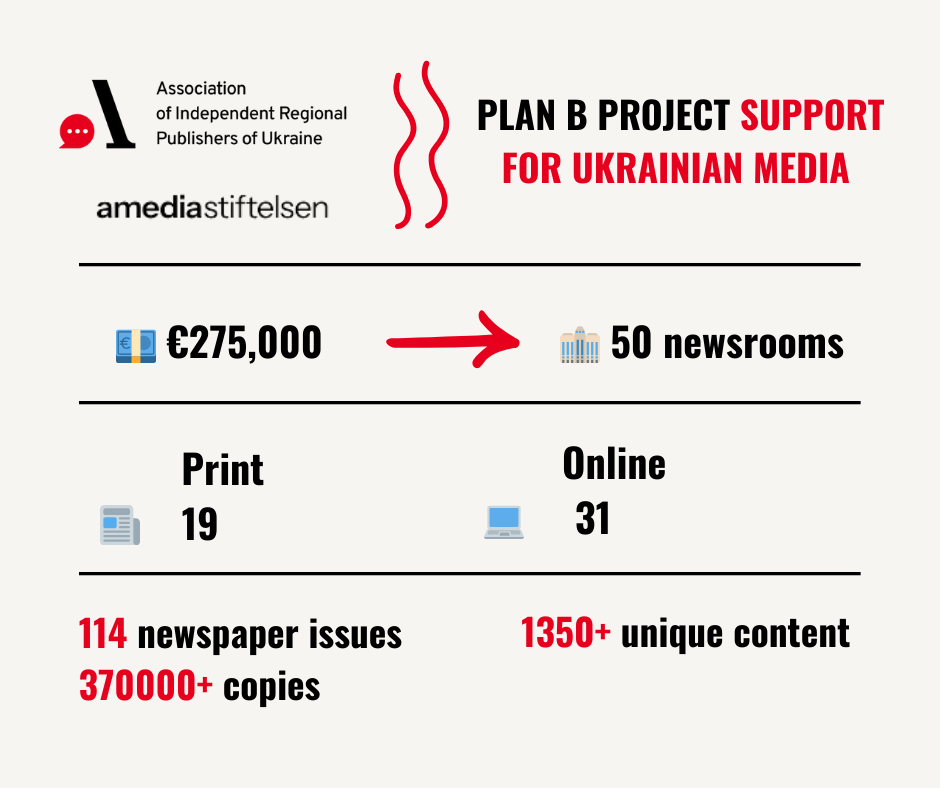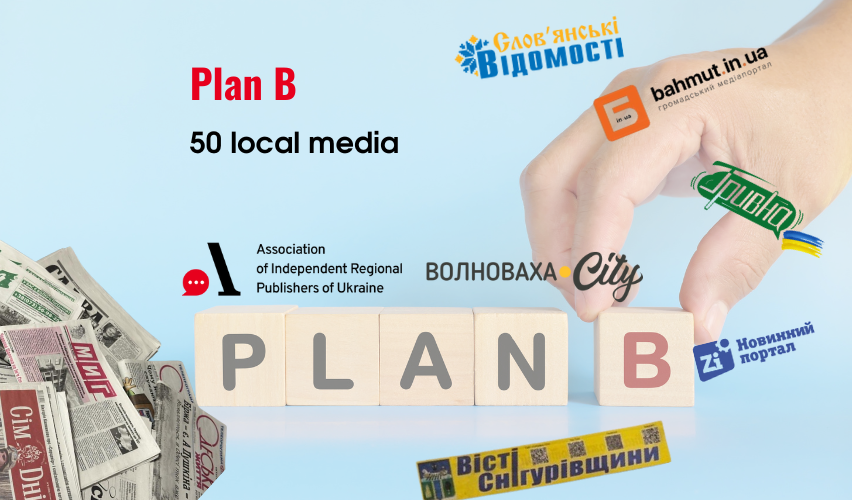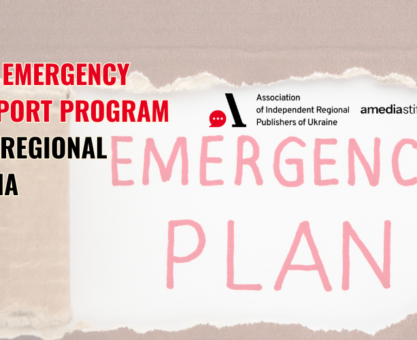The 6-month emergency financial support project for the media has concluded. Here’s what it achieved.
In February 2025, following a sudden halt in funding from American donors, dozens of Ukrainian regional media outlets faced the risk of shutting down. To support newsrooms that play a critically important role in their communities, the Association of Independent Regional Press Publishers of Ukraine (AIRPPU) launched an emergency aid program — Plan B.
The project was made possible thanks to a partnership with the Norwegian media company Amedia Foundation — one of the largest regional media groups in Scandinavia. It provided financial assistance that enabled the rapid launch of two waves of support for 50 Ukrainian newsrooms.

“There was an urgent need to support these media outlets so that they wouldn’t have to cease operations. In response, our foundation allocated €275,000 to help AIRPPU provide the necessary support for local and regional media to keep functioning. We consider the Association to be a reliable and trustworthy partner,” noted André Støylen, Director of Amedia Foundation.
During the program, we supported 19 print and 31 online media outlets. This made it possible to publish over 114 newspaper editions (more than 370,000 copies) and produce more than 1,350 unique content for the digital media.

“As one colleague aptly put it, Plan B wasn’t a crutch — it was a stretcher that carried newsrooms out of intensive care,” summarized AIRPPU CEO Oksana Brovko.
Why This Was Critically Important
Regional media — especially in frontline communities — play a much broader role than just delivering information. They become a communication bridge between people, document the realities of war, help communities navigate danger, and foster cohesion. The loss of funding threatened not just the newsrooms, but could have created “news deserts” where disinformation spreads in the absence of truth.

“Media in frontline regions fulfill not only an informational but also a social mission… Losing funding could lead to mass closures of local outlets,” explains Oksana Brovko.
Voices That Did Not Disappear
Throughout 2025, many Ukrainian regional media outlets faced enormous challenges: war, evacuations, loss of funding, and a volatile advertising market put their operations at risk. For some newsrooms, participation in Plan B became a chance not only to keep their teams intact but to stay close to their audiences — to keep writing, supporting, and documenting community life.
In Snihurivka — a town that endured 8 months of occupation — the newspaper Visti Snihurivshchyny was the first to resume operations after liberation. Despite a looted office, the loss of their company vehicle, unstable power supply, and constant shelling, the team pulled together. They’re now working on a special project titled “After the Occupation”, a historical section for the paper’s 95th anniversary, articles on mine safety, and online formats for younger audiences.
The editorial team of Gryvna, a Kherson-based publication, returned to their readers just 16 days after the city was liberated. The team works from different cities and countries; some are under shelling, without offices or housing. Yet the paper continues to publish, the website is updated, and social media is active.
“We lack confidence in the future. But we continue working — for Kherson, for our people,” says the newsroom.
In the Sumy region, the newspaper Spilnopillia became the sole source of information for border communities where there’s no phone signal, no working postal service, and newspapers reach people via volunteers.
“This isn’t just a newspaper — it’s a shared mission that helps people feel that life goes on,” says editor Nataliia Kalinichenko.
At “Volnovakha.City”, following the evacuation, only one editor — Anastasiia Kharyna — remained to continue working. She runs the website and social media, consults with lawyers, and writes about the lives of displaced persons and those still in occupation.
“I simply can’t allow the site to die. Even though it’s been on the verge of shutting down more than once,” she says.
Thanks to the support, the outlet managed to bring back another journalist, launch a Telegram channel for residents in occupied areas, and translate materials into English.
These stories are vivid proof of dignity, connection, and journalism as a form of service. And it was Plan B that made the impossible possible: staying with the people when everything else was falling apart.
The Changes Made Possible
As we can see, Plan B enabled not just survival, but transformation:
- launching new platforms and Telegram channels,
- resuming print editions after occupation,
- expanding audiences, including international ones,
- producing investigations, special projects, and video content,
- rehiring journalists after layoffs,
- beginning to build communities and new funding models.
For example, “Poltava Wave” launched a media school, an investigative unit, and a travel project about Ukrainian artisans.
“Bahmut IN.UA” created a dossier on collaborators, a fact-checking section called Brekhomir, and invested in SEO optimization and community building.
What’s Next
Plan B was never intended as a long-term institutional solution. But it affirmed one essential truth: these newsrooms matter — they are alive, and they are carriers of truth on the ground.
“Plan B emerged as an emergency project, aimed at supporting those who, in the most difficult moment, held the line of communication, documented reality, and gave their communities a sense of stability. We now see that this support allowed the newsrooms not only to survive, but to become even stronger,” concludes Oksana Brovko.
During her trip to Arendalsuka — Norway’s largest democratic event — Oksana Brovko met with partners from the Amedia Foundation. At the meeting, they discussed the outcomes of Plan B and the possibility of continuing support for Ukrainian regional media outlets that have yet to secure new sources of funding and remain in need.


















